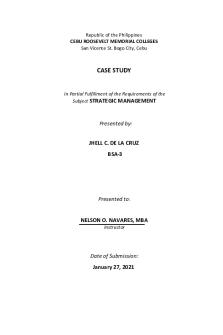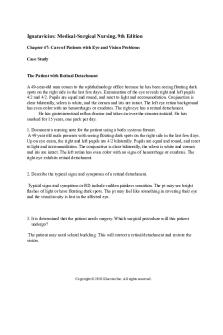BUSN 333 Case Study Ch 2 - The Xerox Alto Case questions PDF

| Title | BUSN 333 Case Study Ch 2 - The Xerox Alto Case questions |
|---|---|
| Course | Project Management |
| Institution | MacEwan University |
| Pages | 2 |
| File Size | 60.7 KB |
| File Type | |
| Total Downloads | 39 |
| Total Views | 172 |
Summary
The Xerox Alto Case questions...
Description
Paradise Lost: The Xerox Alto The Xerox Alto is a fascinating story of a large organization’s fumbling the biggest technological advance in the latter half of the 20th century. Xerox should have been poised to reap billions. It invested in an advanced research center (PARC), hired the best and brightest talent in this fledgling industry, and was first off the mark with a fully-functioning PC, including Ethernet, laser printing, word processing, spreadsheets, and so forth. Instead, this case also details how they managed to squander their opportunity through a moribund culture, and attitude of “playing it safe,” and the inability to think creatively. In short, the Alto was simply too much for Xerox to know how to handle it.
Questions:
1)
Do you see a logical contradiction in Xerox’s willingness to devote millions of dollars to support pure research sites like PARC and then refusing to commercially introduce the products produced?
Absolutely. This contradiction is one of the compelling points in the story. Discuss the difference between research for its own sake and the need to bring it to market. Also, did the Alto and the culture that created it violate Xerox’s strategic mission at the time, which seemed designed to play it safe and stick with simple, incremental products, rather than attempting to take quantum leaps forward.
2)
How does Xerox’ strategic vision work in favor or against the development of radical new technologies such as the Alto?
Xerox had allowed their culture to become moribund and hence, their strategic focus was on making incremental improvements. The irony, as instructors may wish to bring up, is that the original Xerox innovation, the model 900 copier, was a radical innovation for its time and led to huge profits for the company. Thus, an organization which made its fortune and reputation on a
highly successful and radical innovation, could not bring themselves to do the same thing a decade later with the Alto opportunity.
3)
How did other unforeseeable events combine to make Xerox’s executives unwilling to take any new risks, precisely at the time that the Alto was ready to be released?
Over the five years after the development of the Alto, a series of ill-timed acquisitions, lawsuits, and reorganizations rendered the PC a casualty of inattention. What division would oversee its development and launch? Whose budget would support it and PARC in general? By leaving those tough decisions unmade, Xerox wasted valuable time and squandered their technological window of opportunity.
4)
“Radical innovation cannot be too radical if we want it to be commercially successful.” Argue either in favor of or against this statement.
This question can lead to an interesting discussion regarding the advantages and disadvantages of radical innovation. Arguments can be made for both radical change and “logical incrementalism” in new product development and introduction. One important factor to consider is the nature of the industry in which the organization is operating. For example, it could be argued that office products and information technology, which is the setting in which Xerox competed, requires a willingness to make the radical changes that would not be as necessary in other settings, facing less frequent or serious technical changes....
Similar Free PDFs

Xerox Corporation- Case Study
- 9 Pages

CASE 2 Xerox Corporation
- 8 Pages

Case study ch 2
- 3 Pages

Case 3 Questions - case study
- 1 Pages

Case Study Questions #1
- 2 Pages

Case Study - Full questions
- 6 Pages

Case study IKEA Questions
- 5 Pages

GMS Case #2 - GMS case study 2
- 2 Pages

TS Ch 13 Case Study
- 2 Pages

Ch 6 Bone case study
- 2 Pages
Popular Institutions
- Tinajero National High School - Annex
- Politeknik Caltex Riau
- Yokohama City University
- SGT University
- University of Al-Qadisiyah
- Divine Word College of Vigan
- Techniek College Rotterdam
- Universidade de Santiago
- Universiti Teknologi MARA Cawangan Johor Kampus Pasir Gudang
- Poltekkes Kemenkes Yogyakarta
- Baguio City National High School
- Colegio san marcos
- preparatoria uno
- Centro de Bachillerato Tecnológico Industrial y de Servicios No. 107
- Dalian Maritime University
- Quang Trung Secondary School
- Colegio Tecnológico en Informática
- Corporación Regional de Educación Superior
- Grupo CEDVA
- Dar Al Uloom University
- Centro de Estudios Preuniversitarios de la Universidad Nacional de Ingeniería
- 上智大学
- Aakash International School, Nuna Majara
- San Felipe Neri Catholic School
- Kang Chiao International School - New Taipei City
- Misamis Occidental National High School
- Institución Educativa Escuela Normal Juan Ladrilleros
- Kolehiyo ng Pantukan
- Batanes State College
- Instituto Continental
- Sekolah Menengah Kejuruan Kesehatan Kaltara (Tarakan)
- Colegio de La Inmaculada Concepcion - Cebu





